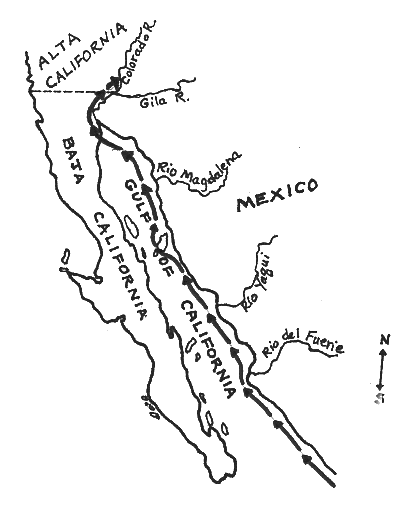| ||||
|
| ||||
|
HERNANDO
DE ALARCON
 Lived:
in the 1500s
Lived:
in the 1500s
Explored California in: 1540
Exploring for: Spain
Explored: by ship in the Gulf of California and the Colorado River
Hernando de Alarcón may have been the first European to set foot on Alta (Upper) California, or what is now the state of California.
EARLY HISTORY
Alarcón was a young captain in
the army of New Spain. He was probably born in Trujillo,
BACKGROUND
The viceroy of New Spain in 1540 was Antonio de Mendoza. The viceroy was like the governor of the province, ruling as the representative of the King of Spain. Mendoza had heard the stories of the fabulous Seven Cities of Cibola, said to be made of gold and full of treasures, and Mendoza believed these reports were true.
After several expeditions failed
to find the golden Cibola, Viceroy Mendoza made a bigger plan. He would send
an army under Francisco Vásquez de Coronado to hunt for the cities. Coronado and his
army would take the old Indian trail that went along the western coast of
At the same time, Mendoza would send a sea expedition up the Gulf of California. The ships could carry supplies for Coronado’s land troops, and explore the very northernmost part of the Gulf. Francisco de Ulloa, who sailed up the Gulf in 1539, had suspected that there was a river at the head of the Gulf, but had not reached it. Perhaps that river would lead to the Seven Cities of Cibola. Hernando de Alarcón was chosen to lead the sea expedition.
ALARCON’S JOURNEY
Alarcón left the harbor at Acapulco
(on the west coast of
Alarcón’s ships were armed with cannon, and the sailors had swords and firearms. The ships also carried many supplies of food for the crews (beans, wheat, crates of live roosters and hens) and trinkets to use as gifts with any Indians they might meet.
Alarcón sailed close to the coast as he made his way northward, watching for signs of Coronado’s expedition. As Coronado marched north he, too, was watching for Alarcón. Though Coronado’s group was inland, he sent scouts out to the coast to look for ships. The two expeditions failed to make a connection, probably because Alarcón left two months after Coronado.
It took more than three months for Alarcón to reach the top of the Gulf of California. He saw the sandbars with the wild water over them, as described by Ulloa the previous year. And he was determined to cross them and find the river that must be there. Not only had the Viceroy commanded that he do so, but Alarcón was hopeful that he would be the one to find the Seven Cities of Cibola, and thus be a hero.
Finding the River
The first attempt to find a way through the sandbars ended with all three ships being stuck in the sand. Fortunately, when the tide came in the ships were afloat again and they edged in through the sandbars. This time they came to the very end of the Gulf. Alarcón wrote: “… and here we found a mighty river with so furious a current that we could scarcely sail against it.”
Alarcón named the river Rio de Nuestra Señora de Buena Guía, or River of Our Mother the Good Guide. We now call it the Colorado River.
That “furious current” that Alarcón described was the tidal bore created when waves of 20 to 30 feet in height rolled upstream to meet the strong current of the river coming downstream. The meeting of these waters created a collision that felt and sounded like an earthquake.
Exploring the River
It was impossible to take the ships up this river, so Alarcón equipped two launches (small boats) for the trip. He took only about 20 of the most experienced sailors with him. The launches had to be rowed with oars and pulled by ropes by men walking along the banks of the river. It was hard work.
On the way, Alarcón convinced the Indians living along the river that he meant them no harm, and they gladly helped him, perhaps thinking he was a god. He traveled for twelve days up the river before deciding to return to his ships to get food supplies and more men. By the time he started back upriver, however, the attitude of the Indians had changed. They had heard that Coronado’s army had killed many Indians. Because of this, none of the sailors nor Indians was willing to help Alarcón locate Coronado. So Alarcón returned to his ships, sad that he had failed to find Coronado or the Seven Cities of Cibola.
WHAT HE ACCOMPLISHED
What Alarcón had become was the first European to reach Alta (Upper) California. His description of the place where he turned around to head back downriver is near the present-day location of Yuma, Arizona. Across the Colorado River from Yuma is California. Alarcón did not say whether he went ashore on the west bank of the river, thus standing on California soil, but he certainly saw it.
LATER YEARS
Alarcón returned with his ships to New Spain. He played no further role in the history of California.